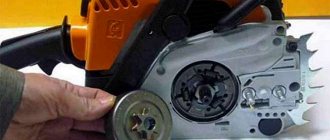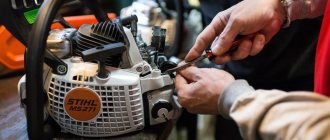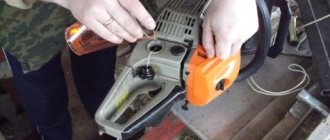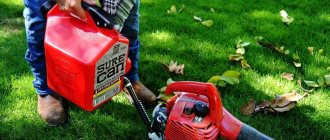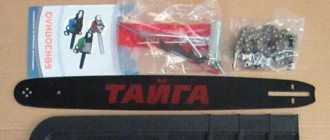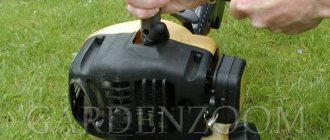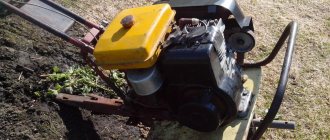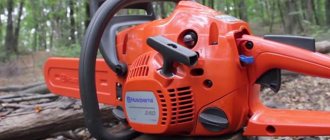Chainsaw carburetor design
Almost all carburetors used in the production of chainsaws have the same design. The only difference is the mechanisms with which Chinese garden tools are equipped.
As standard, the fuel unit consists of the following parts:
- float chamber - this element is designed to continuously maintain the required amount of fuel. When the unit is operating, fuel is transferred through a built-in nozzle to the atomizer;
- tube - through it, fuel enters in portions into the chamber. The fuel supply is regulated by the position of the built-in factory damper;
- atomizer - this part is necessary for injecting fuel into the intake air flow.
The operating principle of a chainsaw carburetor is quite simple. During operation of the unit, air is sucked into the tube and passes through it at a speed that is regulated by the built-in damper. When the damper opens, the float located in the chamber is activated. After passing through the diffuser, the air is mixed with fuel and instantly atomized. Next, the high-quality fuel mixture enriched with air passes through the intake channel and enters the engine cylinder. The diagram will clearly tell you about the operation of the carburetor.
The fuel circulates in the unit under pressure. In the float chamber it is close to atmospheric, but in the standard tube that sucks in the air, it is more rarefied. Due to the difference in the pressure generated, the fuel mixture enters the tube. The greater the amount of fuel, the higher the speed the engine of a household chainsaw can create.
How to flush a chainsaw carburetor?
You can clean the carburetor on a chainsaw using any aerosol cleaner. The brands Mannol, Hi-Gear and Nowax have proven themselves best. These compounds are good at cleaning the walls and parts of the carburetor from accumulated dust, carbon deposits and hardened resin.
Both Chinese and German carburetors are washed in the same sequence.
Cleaning the carburetor on a chainsaw is performed in the following order:
- First, you need to drain the used fuel remaining in the fuel tank. Next, you need to unscrew the mount and remove the protective cover of the chainsaw body, and also remove the standard air filter;
- Next, you need to remove the hose responsible for supplying fuel. To do this you will need to open the latches. After this, you need to unscrew the fasteners and remove the top cover of the factory assembly housing;
- Next you will need to remove the cover with the blue gasket, which plays the role of a fuel pump membrane. Near the body there are brackets in the form of springs. They will need to be removed and the screws removed;
- Then you need to unscrew the screw and carefully remove the needle valve. Directly below it is a built-in spring, which also needs to be removed. After this, you need to pull out the damper and the standard axle, carefully pulling them along towards you;
- After this, you will need to remove the drive arm, as well as the throttle body and its factory axle;
- All extracted parts of the chainsaw carburetor will need to be laid out on paper and their integrity checked. If necessary, worn parts must be replaced;
- Next, all dismantled parts must be washed with a spray can. The same must be done with the float chamber and carburetor body.
- After complete drying, all parts must be installed in the reverse order.
After washing, the carburetor will need to be installed in its regular place in the chainsaw. Next, you will need to start the garden tool and observe its operation at idle and maximum speed.
Adjusting the chainsaw carburetor
This procedure is necessary specifically in cases where a garden tool does not start or, after starting, immediately stalls. Adjusting the carburetor of a chainsaw is also necessary when its power has dropped or the amount of fuel consumed has noticeably increased.
For self-adjustment, each manufacturer includes adjusting screws in the package of their garden equipment. The bolt, marked H, is used to adjust the position of the main jet and the operation of the internal combustion engine at high speeds. Bolt L is necessary for basic adjustment of the position of the built-in idle speed jet generated by the motor. Accordingly, the T screw is required by the chainsaw owner to quickly adjust the idle speed of the factory engine. In some cases, this bolt is also marked with the letters S or LA.
Chainsaw Sneezes and Stalls
Content
The chainsaw starts and stalls, the reason
A chainsaw has long been no longer a luxury, but a necessary tool for anyone who has at least some suburban area. With its help you can carry out gardening work, harvesting firewood, processing lumber and much more. There are many models of chainsaws on sale, varying both in power and overall quality. You can verify this here. e-catalog.ru.
But no matter what equipment can be capricious, and chainsaws are no exception. Let's look at more relevant difficulties.
The tool stalls immediately after starting
One possible reason is a lack of fuel. Check the amount of fuel in the gas tank and add as needed. In all this, you should strictly follow the advice in the instructions, especially with regard to the properties of gasoline and oil. In our country, such subtleties are often ignored, filling the saw with whatever is necessary, which causes accelerated wear of the motor and leads to failures.
READ What the STIHL 180 chainsaw looks like
The saw may also stall due to deterioration in the contact of the spark plug with the high-voltage wire. This may be caused by mechanical shear or carbon deposits. From time to time, it is recommended to occasionally replace the candle with a new one, even if the old one did not show any problems in operation.
Chainsaw stalls when pressing on gas
The video discusses a fairly common malfunction of chainsaws
and 100% carburetor option method. How did you do it?
The chainsaw stalls when you press the gas
The chainsaw stalls
when you press the gas.
The Partner 370
chainsaw to stall with the slightest pressure on the handle.
The chainsaw can work normally when in a straight horizontal position, but stalls when tilted to the side. Usually this is also associated with a lack of fuel: the fuel tube rises when tilted, and if there is not enough fuel, it rises above the fuel level.
Chainsaw stops idling
Firstly, it is recommended to check the muffler, because its contamination can lead to a deterioration in the exhaust gases, which is why the engine stops.
READ Launch of Chainsaw Shtil MS 170 Show Video
If cleaning the muffler did not help resolve the problem, and your saw has a carburetor engine, then you can try adjusting it. Most engine models have coarse and fine adjustment bolts (H and L, respectively). By increasing the engine speed with their help, you can eliminate the problem. Keep in mind that carburetor adjustment is a fairly specialized process that requires the implementation of a tachometer.
The engine cannot withstand the load
If the chainsaw stops right in the middle of a particularly thick log, then the problem may be caused by problems in the fuel supply system or problems with the air filter. The engine simply does not get enough flammable consistency to work with a heavy load, and it stops.
The usual solutions to these problems are changing the fuel in strict accordance with the advice in the annotation (we have already talked about this) and cleaning (replacing) the air filter.
The chainsaw stalls when the speed increases
The reasons for this phenomenon are similar to the previous ones: either the problem is in the fuel system or in the air filter. Try disconnecting the fuel hose from the carburetor - if gasoline flows poorly (but you know for sure that there is fuel in the tank), then the reason is the gasoline filter. You can also check the fuel pump - fuel should not leak through it. If this happens, then it is advisable to replace the pump.
READ Chainsaw Oleo Mac Gs 44 16
How to properly adjust the carburetor on a chainsaw?
Before setting up the carburetor on a chainsaw, you need to carefully prepare for the procedure. First of all, you need to find descriptions of the angles of rotation of the adjusting screws in the instruction manual. If you arbitrarily turn the bolts without following the manufacturer's instructions, this can lead to serious damage to the engine of the tool.
The motor itself must be in full working order. You should also thoroughly clean the air filter before tuning. Otherwise, it will not be able to pass air in the volume required to enrich the fuel mixture, which will lead to incorrect carburetor settings.
Adjustment of the unit must be performed on a flat surface. The saw itself should be installed so that its saw attachment is located away from the operator's feet and face. Immediately before tuning, you will need to remove the upper part of the protective plastic body of the tool, as well as remove the foam rubber and part of the standard air filter. To configure the unit, you will need a thin shaped screwdriver.
The chainsaw becomes stubborn (+);
Hello. Out of ignorance, I broke one commandment - not to pick up devices with internal combustion engines at a landfill, and took a chainsaw there.
The thing that won me over was that the starter was resisting - there was compression.
There is also a spark, good and energetic.
The device breathes gasoline vapors; gasoline did not leak out of the spark plug hole.
I diluted the unknown gasoline that was in the saw with undiluted known working gasoline (about half to half).
I changed the spark plug (tried three different ones, one of them was new)
I read on the Internet how to adjust the carburetor and set the obviously “working” settings.
I took an old Soviet compression gauge, bent over, stuck it to the spark plug hole, pulled... with two or three pulls I inflated 7 atm without any problems (I consider this a quite “real” value, even if it’s not a fresh engine). However, I’m not sure that I tucked the device in tightly enough. Inconvenient - terrible! I climbed with a flashlight to look at the piston from three sides - I liked it. Very slight traces of the joint work of the piston and cylinder, not a hint of pathological wear.
The motor rests on nothing!
I read here on the forum that the magnet on the flywheel may have “something strange there”, which is why the ignition timing is gone. Unlikely, but still?!
I also read that air leaks in the engine (under the piston) can be decisive. Replacing crankshaft bearings and seals - will it help?
Pouring fuel directly into the carb and/or cylinder did not result in contractions.
With numerous jerks (and regular cleaning of the spark plug), I observed variable resistance on the starter, which may seem like flashes of the mixture in the engine (but at the wrong time, since it won’t start).
Once with an old candle and having just heated the candle well on a hair dryer, with a hot candle the saw started up! for about 5 seconds, I didn’t even have time to put on the gas, it stalled again and that’s it, that’s all she called.
Another day I brought her a new candle, before screwing it in - let me pull it! I just read on the Internet how to start a saw correctly. Jerg! From the very first kick it starts for 2-3 seconds and again there is dead silence.
Additional question. There is an old Soviet strobe, which, when connected to 12 V, squeaks quite disgustingly. It was not possible to get the strobe to work. Maybe I'm doing something wrong? Should the signal wire only touch the BB wire going to the spark plug?
Please advise what else can be done! I created the topic out of a lot of emotions, it’s necessary to rely so much on the piece of hardware in which there seems to be nothing to break! :pardon: What do you think?
I almost forgot: the Komatsu Zenoah G380 machine, the Internet knows practically nothing about it.
I licked the carburetor settings from here. Modified on December 29, 2010 by young technician
What to do if gasoline does not flow into the carburetor of the chainsaw?
The first reason for this failure is that the fuel filter is clogged with dust and dirt. This happens due to the presence of a large amount of harmful impurities in gasoline and the used motor oil. Over time, they accumulate on the surface of the filter, causing it to lose its ability to pass fuel. To solve the problem, you will need to thoroughly clean the filter by rinsing it in a bath of cleaning agent. If the filter develops holes or other signs of wear, it needs to be replaced immediately.
The second cause of failure is contamination or breakage of the tube through which fuel is supplied to the carburetor. If the hose is not torn, then cleaning it will be enough to thoroughly blow it with compressed air from an aerosol. If the tube is broken, it will need to be replaced. When installing the hose, the joints between it and the fittings must be carefully treated with sealant.
There is one more malfunction that occurs much less frequently than the previous two. It consists of a breakdown of the valve that regulates the rate of fuel supply to the carburetor. If dust or small chips get inside its mechanism, the damper is blocked and remains in the closed position. Repair of the unit can only be done by replacing the damper, since it most often cannot be restored.
Why does the saw only work on suction?
The reason for this may be either a clogged carburetor (its jet) or contamination of the filter itself (fuel). ... In order to solve this kind of problem, all you have to do is disconnect the (fuel) hose from the carburetor and pay attention to whether fuel is leaking out of it.
Interesting materials:
Is it possible to prune Scots pine? Is it possible to prune thuja and when? Is it possible to trim a video in VLC? Is it possible to prune an adult ficus? Is it possible to prune jasmine in the fall? Is it possible to sheathe a wooden house with corrugated sheeting? Is it possible to sheathe a house with corrugated sheets? Is it possible to cover the ceiling with chipboard? Is it possible to sheathe siding without insulation? Is it possible to rest slabs on aerated concrete?
Why does a chainsaw shoot into the carburetor?
Often, chainsaw carburetor malfunctions are associated with loud extraneous sounds that come from the unit. Ignoring them will lead to even more serious damage, which will be much more difficult to eliminate.
First of all, you need to understand the causes of extraneous sounds. The first of them is an incorrectly set ignition, due to which the used fuel does not have time to burn in the internal combustion engine cylinder in time. This leads to the formation of a short-term shooting noise that is repeated with each cycle of fuel injection into the cylinder.
To fix the problem, you need to adjust the gap between the flywheel and the standard ignition coil of the chainsaw. To do this, you need to remove the left protective cover of the plastic case and clean the parts underneath. To the right of the ignition coil there are 2 screws, turning them counterclockwise will allow you to move the flywheel away from the standard coil. Next, you will need to attach a template to the side of the coil and begin to slowly turn the factory screws in the opposite direction. As soon as the built-in flywheel comes close to the previously installed template, you will need to stop turning the screws.
After adjusting the ignition gap, you need to check the operation of the chainsaw. If it still fires, then you need to inspect the spark plug. If carbon deposits have accumulated on it, the part must be cleaned and completely dried.
Another reason why the chainsaw you are using is firing is due to the incorrect proportion of the prepared fuel mixture. If there is too little gasoline or motor oil, the engine of the garden tool will not be able to operate stably. In this case, you will need to completely drain the fuel and prepare the mixture in accordance with the manufacturer's instructions.
In some cases, a disturbance in the supply of fuel to the engine cylinder may be caused by improper operation of the standard carburetor jets. In this case, you will need to adjust the carburetor and alternately check the operation of the tool at idle, low and high speeds.
Do-it-yourself chainsaw construction and tool repair
A chainsaw is a valuable tool in the household today. For many owners of country houses, this unit has become indispensable. Despite its fairly simple design, the tool sometimes fails. However, almost anyone with a certain amount of knowledge in the field of technology and a set of necessary tools can repair a chainsaw on their own.
Chainsaw device
The simple design of the tool allows you to repair the chainsaw yourself. The main elements of the unit are the following:
- Power point.
- Clutch.
- Oil pump.
- Chain transmission.
- Chain catchers and brake system.
Depending on the brand, some changes may be made to the design of a particular instrument. For example, the engine can be located horizontally or vertically. In professional saws, the second option is most often used. Thanks to the horizontal arrangement of the power plant, the dimensions of the tool are significantly reduced, which is important for home use. Knowing the structure of the unit, you can quickly understand how to disassemble a chainsaw.
The most common tool malfunctions
No matter how competently the unit is operated, problems occasionally arise in the operation of its systems. To fix them, you need to determine the cause. Knowing the design of a chainsaw, we can say that most often problems arise with the operation of the engine. However, do not forget about other components that are also subject to wear.
Problems with the power plant
It can take quite a lot of time to identify the cause of an engine malfunction. Among the main signs of failure, several main ones should be noted:
- The engine does not start.
- The power plant starts to work, but quickly stalls.
- Maximum power is not achieved at idle speed.
- There are interruptions in work.
When diagnosing a malfunction, it is necessary to use the method of exceptions. It is better to start checking with those reasons that will require a minimum of time to eliminate. Most often, a power plant malfunction is associated with the ignition system. It is the condition of the spark plug that can say a lot about the operation of the entire engine. First, using a special key, you need to remove this element and then check its external condition. The performance of the ignition system can be easily determined by sparking. When a strong and stable spark appears, you should proceed to inspect the fuel supply system.
The following problems are possible in its operation:
- A clogged breather cap prevents fuel flow.
- The fuel filter is dirty.
- Insufficient fuel is supplied from the carburetor to the cylinder.
To eliminate the malfunction, you should disassemble the system and clean it thoroughly. Problems with fuel supply can be caused by contamination of the corresponding filter, which interferes with the process of creating a high-quality fuel mixture. If the chainsaw stalls under load, you should inspect the muffler, in which a large amount of combustion products could have accumulated. The most difficult problem is the malfunction of the cylinder-piston group. This applies not only to the repair of Chinese chainsaws, but also to products from well-known brands. In such a situation, it is practically impossible to do without purchasing spare parts.
Lubrication system and chain brake
When using the tool, special attention should be paid to monitoring the operation of the chain lubrication system. Most often, problems arise due to clogging of the channels through which lubricant is supplied. If there is a slight oil leak, you can continue working with the chainsaw. Otherwise, it is necessary to take urgent measures to eliminate the malfunction.
The first step is to check the tightness of the connections between the fittings and the tubes. It is quite possible that these parts will need to be replaced, but everything can be done by simply replacing the sealant. Don't forget about the oil pump, which needs to be checked visually. It must be replaced if there are cracks in the housing. Problems with brake operation most often arise due to contamination of the brake band.
Recommendations for use
To increase the life of the tool, you must follow some rules. This primarily concerns the saw chain and guide bars. It is recommended to replace the chain every three hours and turn the guides 180 degrees. As a result, these elements will wear out evenly, which will extend the life of the entire tool.
During operation, it is important to constantly monitor the cleanliness of the chainsaw. When sawing wood, the unit quickly becomes clogged with sawdust, which must be removed in a timely manner. Contamination of the technological holes can cause problems with the operation of the fuel system. It is also important to change oil and other consumables on time.
How to extend the life of a carburetor?
To prevent the breakdown of a standard unit, the owner of a garden tool should adhere to a number of rules. These include:
- using a properly prepared fuel mixture - each time you mix gasoline and engine oil, you must strictly adhere to the proportions specified in the operating instructions;
- use for refueling gasoline of the brand specified by the manufacturer - for operating an engine running on AI-92 gasoline, AI-95 fuel is not suitable, and vice versa;
- regular washing - cleaning the unit from dust and dirt accumulated on the walls will make its daily work easier;
- tuning the unit immediately after detecting problems - there is no need to delay adjusting the carburetor, as this can lead to even more serious damage.
During operation of the chainsaw, you need to ensure that dust, sawdust and small debris do not seep under its body. Otherwise, they will quickly clog the carburetor and block its operation.
Causes and solutions
Undoubtedly, after reading this title, you continue to read this paragraph and this is not surprising.
The carburetor is one of the most important components of any modern chainsaw. Its main task is to mix the fuel mixture with air, as well as further supply the finished fuel into the cylinder of the gasoline engine. During operation of a chainsaw, its carburetor is constantly working, therefore, over time, this unit begins to need adjustment and flushing. Performing these procedures is quite simple if you are extremely careful and follow the correct procedure.
No. 1. Chainsaw won't start
If difficulties arise with starting a chainsaw, many immediately blame the carburetor. In fact, there are several options and the cause of the malfunction can be any:
- Air and/or fuel filters are clogged. The problem can be solved by cleaning the filters.
- Lack of fuel in the tank. Yes, there is such a reason - some owners forget about such an insignificant detail as refueling a chainsaw and think that a couple of liters of gasoline will last for six months. In addition, fuel in the tank should not be stored for more than 14 days, because gasoline evaporates and the octane number is lost.
- Check the pipe from the fuel tank to the carburetor - it could be clogged or broken, so gasoline does not flow into the tank.
- There is no spark at the spark plug. Why there is no spark - there can be many reasons: there is no contact, the spark plug needs to be changed or it is flooded. Why the spark plug on a chainsaw fills is another question. But if this happens, you need to dry it and reinstall it, and then check for a spark. If there is heavy carbon deposits on the spark plug, it is recommended to replace it.
- Check the muffler for carbon deposits. If there is carbon deposits, thoroughly clean the muffler, but it is still recommended to take the chainsaw to a service center to have the cylinder and piston checked, because carbon deposits are a sure sign of improper operation of the elements of the cylinder-piston group.
- The carburetor is clogged. How to properly adjust a chainsaw so that the carburetor works well is discussed in a separate article.
If none of the above methods helped, then the reason is more serious - a breakdown of one of the connecting rod-piston group units. In this case, it is recommended to take the chainsaw to a service center.
Repairing the gas handle of a chainsaw. Disassembling and assembling a chainsaw with your own hands
The low level of technical equipment of many service departments and the high cost of their services forces many owners of faulty chainsaw equipment to repair their gadgets themselves. How to disassemble a chainsaw, replace faulty parts, and also correctly assemble a chainsaw with minimal time and money?
Self-disassembly of a chainsaw requires the availability of spare parts, appropriate tools and plumbing skills. It is possible that to dismantle individual parts you will need special pullers, the manufacture of which will take more time than the repair itself.
In a number of modern models of household and semi-professional chainsaws, special keys not included in the supplied kit are used to dismantle the drive sprocket of the saw chain.
Self-repair problems
The problem in many cases is complicated by the lack of comprehensive information on repair technology. According to foreign manufacturers, after the saw has exhausted its service life, it should be scrapped, so the maintainability of many budget-level models raises reasonable doubts.
Professional-grade chainsaws are more difficult to restore.
- The problem is compounded by the high cost of spare parts.
- It is possible that to restore the functionality of individual components and mechanisms, in particular, to configure fuel equipment, special equipment will be required.
Replacing expensive branded parts with affordable but short-lived Chinese analogues does not justify itself economically. Practice shows that these components produce a service life of 50-60% at best.
Fault detection algorithm
The cause of saw failure or deterioration in its performance may be:
- clogged fuel tank cap breather;
- air leakage from the carburetor due to the destruction of the gasket or loosening of the threaded fasteners;
- mechanical jamming of removable saw equipment and other minor defects.
Before you begin disassembly, you should make sure that more extensive repairs are necessary.
It will most likely not be possible to independently assemble a new chainsaw after repair with the original quality. The design of modern chainsaws often uses press fits of mating parts, which have minimal repairability.
Even partial disassembly of a chainsaw using improvised tools can lead to undesirable consequences. In most cases, to eliminate a malfunction, you can limit yourself to dismantling a separate unit or system.
This list includes:
- connecting rod and piston group;
- carburetor;
- clutch mechanism;
- saw chain drive sprocket.
Tips for dismantling various components and systems
In the scope of this article, only general recommendations can be given, since chainsaws from different manufacturers may have significant technical differences.
Before disassembling a faulty tool, it is necessary to dismantle the saw set, drain the fuel and oil from the filling containers, and clean hard-to-reach places of the chainsaw from surface contaminants.
Fuel supply system
Disassembling the carburetor requires special attention. This assembly consists of many small parts, so the removed parts in a given sequence are placed on a clean sheet of paper. After washing all components, the carburetor is assembled in the reverse order.
Compression recovery
Less complex repair of the piston group. To dismantle the cylinder, it is enough to remove the threaded fasteners and lay the saw on its side to prevent pieces of a damaged compression ring, piston skirt or other foreign objects from getting into the engine crankcase.
The cylinder bore wears unevenly, so installing a new piston does not have a significant effect. As a rule, during a major overhaul, after checking the suitability of the crankshaft, a complete set consisting of a cylinder, piston, compression ring and piston pin is installed.
Starter repair
Disassembling the starter to replace the cord does not create problems for an experienced user, but the plastic case in most cases cannot be repaired. Most are copies of the most popular European models, so we disassemble the Chinese chainsaw according to the standard procedure.
Worn parts of the saw set cannot be restored.
- At home, you can shorten a new chain to fit a shorter bar.
- The service life of branded tire components is equal to the service life of three saw chains.
- This indicator can be significantly reduced by incorrect choice of chain pitch or excessive wear of the drive sprocket crown.
Finishing work
In a number of models, engine control elements, start blocking and an emergency stop system are located on the handles, where the operator’s hand is grasped. It is recommended to assemble the chainsaw handle after preliminary cleaning of the contacts of all electrical and mechanical communications.
Self-assembly of a chainsaw is part of the repair work that requires special attention. The success of the final result is facilitated by the correct sequence of operations, sufficiently high quality of parts, gaskets and other consumables.
No. 2. The engine stalls
The engine starts, but the chainsaw stalls at idle or under load. In this case, most often you should perform the same actions as described above.
How to adjust a chainsaw depends on exactly when the problems start:
Stalls immediately after starting:
- The fuel mixture is not prepared correctly, there is too much oil in it, so the octane number of gasoline is less than it should be, so the chainsaw only runs on choke or stalls immediately.
- Carbon deposits on the spark plug or improper gap between the spark plug and the wire.
It stalls and does not work at idle:
- The muffler is clogged. It is necessary to remove carbon deposits.
- The carburetor settings are off. The idle speed on the chainsaw needs to be adjusted. This is done using adjusting bolts marked L and H. For how to adjust idle speed, see the article about adjusting the carburetor.
Stalls at maximum speed and only runs on choke
- The air or fuel filter is clogged. The seals need to be cleaned and checked.
- The breather is clogged and because of this, fuel does not flow and pumping gasoline on the chainsaw does not work. Take the needle and carefully clean the breather.
- Fuel pump malfunction. Remove the pump and check to see if gasoline is leaking from it. If it oozes, replace the sealing gasket or the pump itself.
The chainsaw does not cut under load and stalls
- The air filter is clogged. It is necessary to take out the filter, clean it well or even rinse it, dry it and install it back.
- Wrong proportion of oil/gasoline mixture. Drain the fuel and remix the oil and gasoline in the correct proportions.
Chainsaw carburetor adjustments and the design of Chinese tools
The carburetor in internal combustion engines is responsible for preparing the fuel mixture. It consists of gasoline, air, and oil. When all these ingredients have been used in the wrong proportions, the engine will not be able to operate properly. To prevent this, adjusting the chainsaw carburetor is necessary.
The principle of operation of the carburetor
Regardless of the manufacturer of the chainsaw, the order and principles of operation of the carburetor remain unchanged. This device consists of several main elements:
- Tapered air supply tube.
- Fuel supply system.
- Adjustable air damper.
Under atmospheric pressure, air, after undergoing preliminary cleaning, enters the narrow part of the tube, where its flow is regulated by a damper. Also here the air becomes rarefied and the resulting vacuum draws flammable liquid from the fuel line. To adjust the fuel flow, a special needle is used, connected to the nozzle chamber. The quality of the fuel mixture is regulated using a damper - when the air is opened, more fuel begins to flow into the carburetor and the power of the power plant increases.
To avoid problems with the operation of the tool, it is necessary to periodically adjust the chainsaw. When too much air enters the mixture, it becomes lean and engine power is reduced. Air deficiency also negatively affects the operation of the unit, as fuel consumption increases. At the same time, it does not burn completely, which leads to the appearance of carbon deposits on the cylinder walls. It is quite obvious that the question of how to adjust the carburetor on a chainsaw is asked by many owners of this tool.
However, first it is worth noting the signs of high-quality operation of the power plant:
- The momentum is picking up quickly.
- The sound when the engine is running is similar to a four-stroke.
- At idle speed the chain does not spin.
Situations in which tuning is necessary
The new tool is already ready for use. In this regard, for some time the question of how to adjust the carburetor on a chainsaw will not arise. However, experienced unit owners often fine-tune the unit. To do this, there is absolutely no need to disassemble the carburetor, since its design has three adjusting screws:
- L - used at low speeds.
- N - allows you to set the maximum supply of flammable liquid.
- T - necessary for idle adjustment.
All fine-tuning actions are carried out by ear, and at this time you must adhere to safety rules. Before starting any manipulations, the adjustment screws should be marked to make it easier to return to the default setting if necessary.
Most often, problems are caused by adjustments that are carried out after failures in the operation of the unit. Among the main reasons for their appearance, it should be noted:
- Unbalance of screws and violation of the location of the protective cap.
- Wear of the piston system, which requires changes to the composition of the fuel mixture.
- Problems with the operation of the carburetor itself.
Adjustment algorithm
All work on setting up a carburetor chainsaw is carried out in four stages:
- The carburetor is adjusted to create and supply a high-quality fuel mixture.
- Fine adjustments are made at idle and only after the power plant has warmed up.
- The quality of the tool is checked in all modes.
The engine is adjusted to ensure smooth operation at low speeds.
And now in as much detail as possible about how to adjust a chainsaw. If the tool does not start, then it is necessary to set the adjusting screws H and L to their original position. Then you have to start the engine and let it warm up. After this, you can begin adjusting at low speeds. To achieve optimal operating mode, screws L and T must be used.
First of all, use screw L to start the engine at maximum speed, and then release it by ¼. Screw T will allow you to adjust the operation of the power plant at idle. Adjustment of traction and maximum speed is carried out using screw H, which must be tightened slowly, while monitoring the readings of the electronic tachometer. It is important to remember that the maximum number of revolutions stated by the tool manufacturer must not be exceeded.
After making adjustments, allow the engine to cool. Then it remains to start it in accordance with the algorithm for starting a cold unit. If there are no problems at this time, and the chainsaw works well at idle, you should check it under load. If a lack of power from the power plant is detected, adjustment is made using screw H.
Almost all Chinese chainsaws are equipped with carburetors, the design of which is similar to European models. Therefore, the differences in setting will be insignificant - during the initial setting, screws H and L must be turned out two turns. All subsequent actions remain unchanged.
No. 3. The engine "shoots"
If during operation there are extraneous sounds similar to gunshots, then there is a problem with the muffler or carburetor. How to make a chainsaw run quietly? It depends on which node is faulty.
Shoots the carburetor:
- Ignition is too late - the air-fuel mixture does not have time to burn out in the cylinder, so the sound is similar to a small explosion.
- Lean air-fuel mixture. Too little gasoline enters the mixture - the chainsaw, or rather the jets, needs to be adjusted to increase the fuel supply. Why the chainsaw revs on its own is for the same reason.
Shoots at the silencer:
- Enriched air-fuel mixture. Why does a chainsaw “shoot”? There is too much gasoline and not enough air in the mixture, so the mixture does not completely burn out in the chamber and partially burns out in the muffler. Carbon deposits on the exhaust are a clear sign of this. The air filter needs to be cleaned or the carburetor adjusted.
A Chinese chainsaw shoots into the carburetor. Why won't it start when hot?
Before starting to solve this problem, it is necessary to note that the productive and correct operation of the engine depends primarily on speed through the use of the starter mechanism. In most models, this “minimum” level is 800 rpm. Air stops flowing into the carburetor in the required quantity, the chainsaw is “calm”. An important fact is that the main reason for a chainsaw not starting is the usual flooding of the engine.
Air damper In order to eliminate this problem, you must first set the air damper to the middle position.
After this, start the chainsaw a couple of times. After the process has begun, warm it up for ten seconds, then switch it to idle mode. After carrying out these manipulations, you can fully open the damper (air). After this, it is worth noting that before you begin directly performing actions regarding the “prescribed recommendations,” try to start the device directly in the idle position. To do this, simply pull the “rope”. Since if the engine is not hot, then the plant will proceed without any problems.
But if you don’t succeed, it means that it has already cooled down enough. In this case, check the half-gas according to the instructions in the instructions that came with your chainsaw.
But if this does not help, in this case, you should directly turn the cold speed screw, directly clockwise.
Remember that the higher the RPM level in your device, the easier it will be for you to start the device. Why does a chainsaw shoot if the chainsaw does not start or shoots into the carburetor. And remember that the chain must be stationary when running relatively cold.
No. 4. Chainsaw overheating
Why does the chainsaw get hot? The engine or tire may overheat - in any case, the fault is due to a small amount of lubricant.
- Engine overheating. The proportion of the fuel mixture is incorrect or pure gasoline is poured. Drain the fuel and make a mixture using the correct proportions of oil and gasoline, as specified by the manufacturer.
- Tire overheating. The oil pump needs to be cleaned or adjusted because... No oil is supplied to the tire.
No. 6. The chainsaw cuts to the side
When cutting, you may notice that the result is an uneven cut. Why does a chainsaw cut crookedly? There are several reasons:
- Incorrect chain sharpening. The teeth are sharpened at the wrong angle or only in one direction. Proper sharpening is required.
- Incorrectly selected chain. At very high speeds, a difference of even 0.2-0.3 mm between the width of the groove or the width of the seat will be visible, which is why the chainsaw cuts to the side. An appropriate circuit must be installed.
- Uneven tire wear. Over time, the tire wears out on one side and then the chain pulls to the side. Rotate the tire regularly to ensure even wear on both sides. If the wear is excessive, replace the tire.
No. 7. Chain lubrication problems
For normal operation, the chain must be constantly lubricated to reduce friction between the bar and the links, and also to prevent premature wear of the links.
- If the chain on the chainsaw is not lubricated, then there is a problem with the oil pump - oil is not supplied due to a clogged channel. Lack of lubrication is the reason why the chain stretches or why the chain breaks. Clean the channels; tiny particles of chips constantly get there and clog them. The oil hose may also break. If you need to adjust the chainsaw oil pump or repair it, it is better to contact a service center.
- Oil splashes from the chain. Incorrectly selected lubricant - it is too liquid, so it does not so much lubricate the links as it splashes onto the wood. Replace the lubricant with a thicker one.
No. 8. The chain falls off
Why does the chain fall off the tire? There may be several reasons and they are all different:
- Worn drive or driven sprocket. Due to the fact that the sprocket is worn out, the grip on the chain decreases, which is why the chain flies off the chainsaw. The sprocket needs to be replaced.
- The chain has stretched. Why the chain on a chainsaw stretches is due to insufficient lubrication. The metal heats up and stretches, even by a fraction of a millimeter, but if you take into account the number of links, then even 3-4 mm is enough for the chain to fly off the bar. The chain needs to be replaced.
- The chain tensioner that regulates its tension has become loose. how to regulate a chainsaw, or rather the chain tension? You need to adjust the tensioner - this can be done in just a few minutes.
Answers to questions, pops in the muffler and longitudinal runout of the crankshaft
I tried to explain why there are popping noises in the muffler at idle and whether it is necessary to eliminate the longitudinal runout of the crankshaft.
They recognize you even without a face, by the marks on your hands and by your voice) Your experience is through the roof and you are doing the right thing by teaching us young people!)
Why is there a clanging sound that doesn’t sound like detonation when it’s cold in the chain area, at 3.5-4 thousand rpm? After you ride, does it disappear?
Hello, I have the same problem! It used to be there, then it disappeared, and now compression has appeared again on the VAZ 2103 1.3.-10. 11. 11. 11.
A friend of mine has this situation: a VAZ 2106 was parked in a garage for 4 years, after starting it turned out that the engine was running with strong vibration, without interruption and absolutely smooth to the ear (Before starting, all seals, caps, gaskets, and valve springs were changed). The vibration partially disappears when warmed up. After measuring the compression, it turned out that the compression is on cylinders 2,3,4
12.5 atmospheres, and on the first
6 atmospheres, with oil rises to
15. The spark plug insulators are the same, brick color. In theory, everything points to a broken ring, but the owner assures that before parking everything was ideal, plus, about 2000 runs before parking, the engine was overhauled and such a problem was not observed. Question for you: could the rings be stuck like this, and in general, what can you say about the laying of the rings in general, what to do, is it possible to do without a bulkhead, or is the chamfer on the valve/seat rusty (after all, some valves were open during parking). In general, I would like to hear your opinion on piston decoking, in particular decoking with water.
Thanks for answers.
Hello, it's me again, I want to say that the clanging sounds like the chain on a motorcycle is loose, but the chain is tight. Compression is 12.5 everywhere, the engine runs and turns very well. In principle, it doesn’t bother me. Maybe this is due to the fact that block 011 elbow 03 short connecting rod and fifth pistons? I was generally told that such a move. not durable(((
Maybe I screwed up at the moment)) Maybe they said, I haven’t heard, where do you live if it’s not a secret?)
There was a problem with the engine misfiring and running rough at idle, I tried a lot, but the solution turned out to be much more trivial than valves and air leaks. It simply pierced high-voltage wires. Diagnostics is very simple - when it gets dark outside, start the engine and look at the high-voltage wires in the dark. If Zeus “settled” there (sparks are visible), then replacing the wires will probably solve everything. Nowadays there are a lot of defects and fakes on sale. Not all yogurts are created equal!
